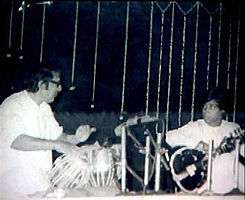Benares gharana

Benares gharānā (Hindi: बनारस घराना) is one of the six most common styles of playing of the Indian tabla.[1]
History
The Benares tabla gharana was developed a little over 200 years ago by Ram Sahay (1780–1826). At the age of nine, Ram moved to Lucknow to become a disciple of Modhu Khan of the Lucknow gharana.
After some time performing in Benares, Ram Sahay felt the need to make a significant change in his tabla playing. For six months, he withdrew into seclusion, and worked to develop what is now known as the Benares baj or style of tabla playing. The philosophy behind this new style of tabla playing is that it would be versatile enough to perform solo, and to accompany any form of music or dance. The tabla would be able to play delicately, as required for khyal, or more aggressively, like pakhawaj, for the accompaniment of dhrupad or kathak dance. Ram Sahai developed a new way of fingering the tabla strokes; especially important is the sound Na, being played with a curved ring finger to allow for maximum resonance of the dahina. He also composed numerous compositions within existing compositional forms (gats, tukras, fard, parans etc.) and created new forms, such as uthan, Benarasi theka, and fard.
Characteristics
Today, the Benares tabla gharana is well known for its powerful sound, though Benares players are also very capable of playing delicately and sensitively. The gharana is categorized into the Purbi (eastern) baj, which includes the Farukhabad, Lucknow, and Benares gharanas. The Benares style makes use of the more resonant strokes of tabla, such as Na (played on the lao), and Din. Benares players preferentially use the full-hand TeTe strokes, rather than the single finger alternation preferred by the Delhi style, though both stroke types are integrated into the Benares baj repertoire.
Exponents
The tabla solo is highly developed in the Benares gharana, and some artists, such as Anokhelal Mishra, Samta Prasad,[2] and Kishan Maharaj,[3] have become famous as tabla soloists. The direct descendants making up the 6th generation of tabla players are Mahapurush Misra, Ananda Gopal Bandopadhyay (disciple of Mahadev Prasad Mishra), and Chandra Nath Shastri (disciple of Anokhelal Mishra). The 7th generation consists of Kumar Bose (disciple of Kishan Maharaj).
Other noted artists include Kanthe Maharaj, uncle and Guru of Kishan Maharaj, and whose disciples were Badri Maharaj and Ashutosh Bhattacharya.[4][5]
The Benares baj makes use of over twenty different compositional types, and has an enormously varied repertoire of each type.
Reputed players from the gharana include Anokhelal Mishra, Samta Prasad, Kishan Maharaj, Mahapurush Mishra, Ashutosh Bhattacharya, Chandra Nath Shastri, Ananda Gopal Bandopadhyay, Kumar Bose, and Udai Mazumdar.
References
- ↑ Kumar, Raj (2003). Essays on Indian music (History and culture series). Discovery Publishing House. p. 200. ISBN 81-7141-719-1.
- ↑ "Samta Prasad". kippen.org. Archived from the original on 7 September 2008. Retrieved 2009-05-01.
- ↑ Shovana Narayan (6 May 2008). "Pt Kishan Maharaj: End of an era". The Tribune.
- ↑ "Biography of Kanthe Maharaj". varanasi.org. Retrieved 24 July 2013.
- ↑ Susheela Misra (1990). Some immortals of Hindustani music. Harman Pub. House. p. 127. ISBN 978-81-85151-14-4.
- Sahai, Sharda and Shepherd, Frances A. 2000 Play Tabla, A Manual for Tabla Playing. Sittingbourne: Asian Education Press.
- Shepherd, Frances A. 1976 Tabla and the Benares Gharana. Ann Arbor: University Microfilms International. (Ph.D. Dissertation).